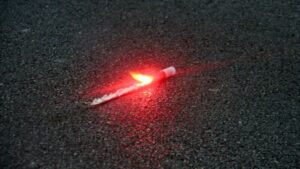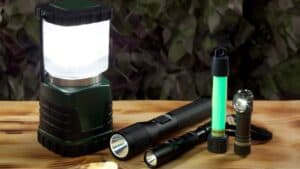A camping lantern can transform your outdoor experience from frustrating to fantastic. The perfect lantern provides adequate brightness while remaining portable and energy-efficient for your adventure. The ideal camping lantern balances brightness (measured in lumens), battery life, weight, size, and durability to match your specific camping style.
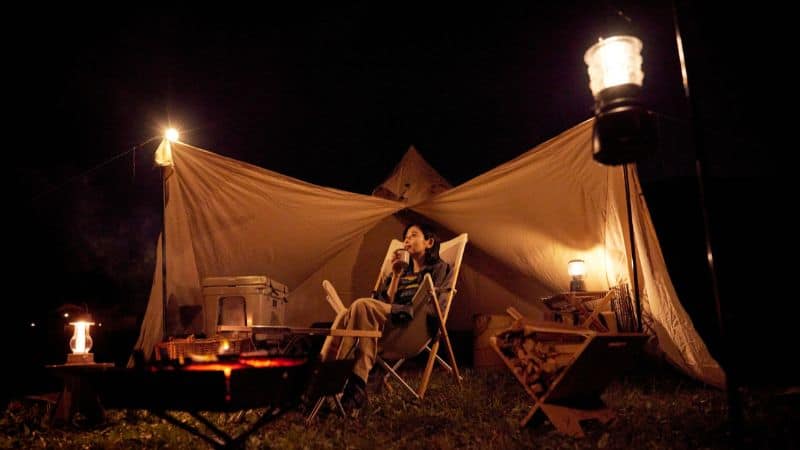
From traditional fuel-burning models to modern LED and solar-powered options, these lighting solutions not only provide practical illumination for cooking and reading, but also create cozy ambiance that makes camping so special.
Let’s explore the 3 types of camping laterns and how to choose the best outdoor lighting solution.
Understanding 3 Lantern Types
There are commonly 3 types of camping laterns, namely, fuel-based laterns, electric laterns and solar-powered laterns.
Fuel-Based Lanterns
Fuel-based lanterns provide exceptional brightness and reliability in outdoor settings. These traditional options typically run on propane, butane, or liquid fuel like white gas or kerosene.
Propane lanterns are among the most popular due to their easy-to-replace canisters and consistent performance. They produce a bright, warm light that can illuminate a large area of your campsite.
Liquid fuel lanterns generate intense brightness and perform well in cold weather conditions where other lanterns might struggle. However, they require more maintenance and careful handling.
Key considerations:
- Brightness: 1000-1500 lumens (typically brighter than electric options)
- Run time: 7-12 hours on a single fuel canister
- Best for: Extended camping trips and cold weather camping
- Drawbacks: Produces heat, requires ventilation, not for tent use
Electric Lanterns
Electric lanterns have revolutionized camping with their safety features and convenience. These battery-powered options eliminate fire hazards while providing reliable illumination.
Most modern electric lanterns use LED technology, offering impressive energy efficiency. A quality LED lantern can run for 50+ hours on a single set of batteries, making them ideal for weekend trips.
Rechargeable models with built-in batteries save money long-term and reduce waste. Many include USB ports to charge your devices, serving double duty at camp.
Features to look for:
- Brightness settings (high/medium/low modes)
- Battery indicators
- Water resistance (look for IPX4 or higher rating)
- Emergency flashers or SOS modes
Electric lanterns weigh less than fuel models and are safer for family camping with children. They produce no fumes and can be safely used inside tents.
Expert Recommendation
The 1600 Lumen Battery Powered Camping Lantern with 360° illumination
Portable Solar Power Camping Lantern with USB-C charging and 2400mAh battery
2-in-1 Camping Flashlight Lantern with warm ambiance mode
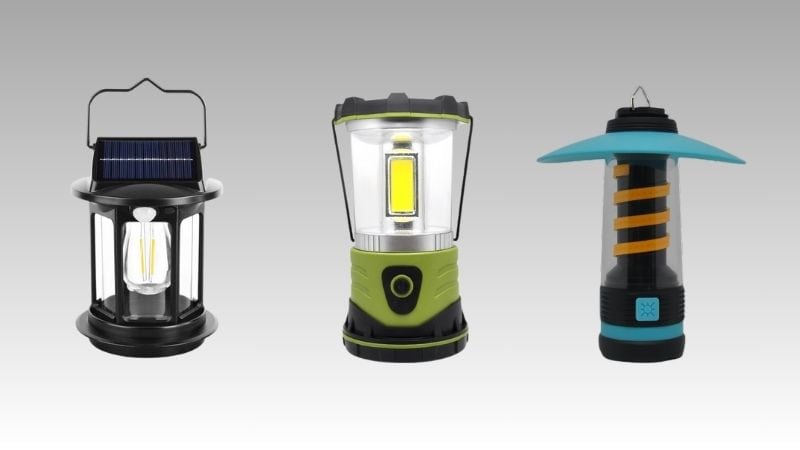
Solar-Powered Lanterns
Solar-powered lanterns represent the eco-friendly option for environmentally conscious campers. These innovative lights harness the sun’s energy through small solar panels to charge internal batteries.
Most solar lanterns require 6-8 hours of direct sunlight to fully charge. Once powered, they typically provide 8-12 hours of light, depending on brightness settings.
The best solar lanterns feature collapsible designs that pack down small in your backpack. Many include USB inputs as backup charging methods for cloudy days.
Benefits of solar lanterns:
- Zero ongoing fuel costs
- Environmentally friendly
- Lightweight (typically 4-8 ounces)
- Silent operation
While solar options generally produce less light than fuel or battery alternatives (30-100 lumens), their sustainability makes them perfect for backpackers and eco-conscious campers. Some newer models incorporate power banks to charge small devices like phones.
6 Key Features to Look for in a Camping Lantern Before Purchasing
Lumens and Brightness Levels
A lantern’s brightness is measured in lumens, with higher numbers indicating more light output. For basic camp tasks, 100-200 lumens typically provides adequate illumination. Family camping often benefits from 200-400 lumens, which can light up a larger area like a picnic table or tent interior.
Most modern camping lanterns feature adjustable brightness settings. This flexibility allows campers to conserve battery power when less light is needed, or increase illumination for activities like reading or cooking.
Consider the environment when selecting brightness levels. In dense forest settings, a lantern with 400+ lumens helps penetrate the darkness. However, stargazing enthusiasts should opt for red-light modes or lower settings to preserve night vision.
Battery Life and Burn Time
Battery life directly impacts a lantern’s usefulness in the wilderness. Most manufacturers list burn time at various brightness settings, typically ranging from 8-200 hours depending on the model and settings used.
Consider the length of your camping trips when evaluating battery life. Weekend campers might be fine with 12-24 hours of runtime, while extended backcountry trips demand longer-lasting options.
Many modern lanterns use rechargeable batteries, which are eco-friendly but require planning for recharging. Others accept standard batteries (AA, D-cell) that can be easily replaced in the field.
Battery types by runtime:
- Rechargeable lithium-ion: Lightweight with 10-40 hours on medium settings
- Alkaline batteries: Reliable with 20-80 hours depending on quantity
- Solar-powered: Unlimited potential but dependent on weather conditions
Smart campers pack backup power sources like portable chargers or spare batteries for unexpected situations.
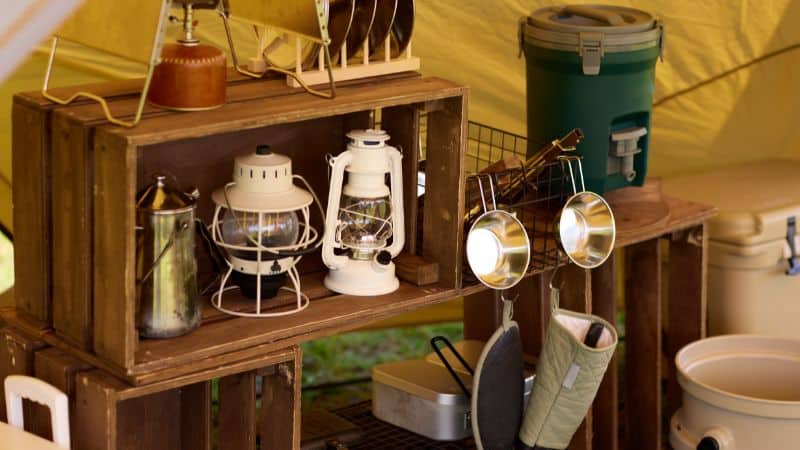
Weight Considerations
Lantern weight varies dramatically based on materials, power source, and design. Ultralight backpacking lanterns can weigh as little as 2-3 ounces, making them nearly unnoticeable in a pack. These minimalist options typically sacrifice brightness and runtime for exceptional portability.
Mid-range options weighing 8-16 ounces strike a balance between weight and functionality. They’re suitable for weekend trips where you’ll be carrying your gear moderate distances.
Car camping lanterns may weigh 1-3 pounds but provide robust illumination and extended runtimes. The extra weight comes from larger batteries, more durable construction, and additional features.
Consider these weight factors:
- Battery type (lithium is lighter than alkaline)
- Construction materials (aluminum vs. plastic)
- Required runtime (larger batteries = more weight)
- Distance you’ll carry the lantern
Waterproof and Impact-Resistant Features
Camping lanterns are rated using the IPX system to indicate water resistance. An IPX4 rating means the lantern can withstand splashes from all directions, while IPX7 indicates it can survive temporary immersion in water.
Look for lanterns with rubber bumpers or protective casings that absorb impact. These features are particularly valuable during unexpected storms or when camping with children.
Many manufacturers test their lanterns by dropping them from specific heights. This information is usually mentioned in product specifications and can help gauge durability.
Some premium models include sealed battery compartments to prevent moisture damage. This design element is crucial for camping in humid or rainy environments.
Materials and Build Quality
Lanterns made from aircraft-grade aluminum offer an excellent balance of lightweight design and durability. These models typically resist corrosion and can withstand years of use.
Polycarbonate plastics provide good impact resistance at a lower cost. They’re less likely to shatter when dropped compared to standard plastics or glass components.
Handle quality is often overlooked but crucial. Reinforced nylon handles or metal bail handles tend to last longer than basic plastic options.
Switches and Control Systems
Modern camping lanterns offer various control mechanisms designed for convenience in outdoor settings. Touch buttons, dials, and remote controls are common options that allow for straightforward operation even with gloves on or in cold conditions.
Look for lanterns with intuitive interfaces that don’t require reading a manual each time you use them. Many newer models include memory functions that remember your last brightness setting when turned on again.
Dimming capabilities are particularly valuable, allowing you to adjust the light output based on your needs. Some lanterns feature color temperature adjustments, switching between warm and cool lighting to create the right ambiance around camp.
3 Additional Features to Look for
Modern camping lanterns offer more than just light. Many include practical extras that can enhance your outdoor experience and solve common camping challenges.
Built-in Power Banks
Many premium camping lanterns now include integrated power banks, allowing you to charge your devices while in the wilderness. Look for lanterns with at least 4000-5000mAh capacity if you plan to charge smartphones. Some high-end models offer up to 10000mAh, enough to recharge most phones 2-3 times.
Consider the number and type of charging ports available. USB-A remains common, but newer models feature USB-C ports with faster charging capabilities. Some lanterns display the remaining battery percentage, helping you manage power consumption.
Remember that using the power bank feature will drain the lantern’s battery faster. For extended trips, prioritize models with solar recharging capabilities to replenish the battery during daylight hours.
Hanging Hooks and Stands
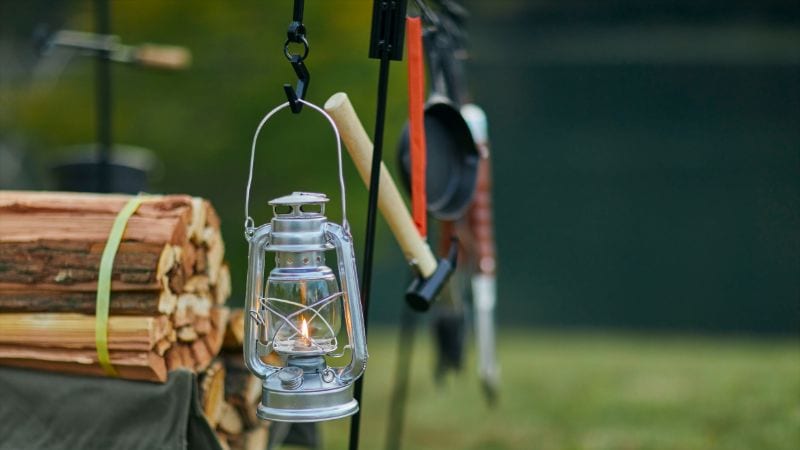
Versatile mounting options can dramatically improve a lantern’s utility at camp. Look for models with sturdy hooks at the top for hanging inside tents or from tree branches.
Some innovative lanterns feature magnetic bases that stick to metal surfaces like vehicle hoods or camp stoves. This hands-free lighting makes cooking and repairs much easier after dark.
Adjustable legs or stands help position lanterns on uneven ground. Models with bendable tripods can wrap around tent poles or tree limbs, providing directional lighting exactly where needed. For group camping, consider lanterns with 360-degree hooks that allow hanging from any angle.
Adjustable Lighting Modes
Most quality lanterns offer multiple brightness settings, typically ranging from 20 to 1000+ lumens. Color temperature options provide practical benefits. Warm light (2700-3000K) creates a cozy atmosphere and attracts fewer insects. Cooler white light (5000K+) offers better visibility for tasks and reading.
Some advanced models include specialized modes like red light for preserving night vision or SOS flashing for emergencies. Dimmable settings help conserve battery life when full brightness isn’t necessary.
Environmental Considerations
Modern lanterns offer sustainable options that don’t compromise on performance or reliability.
Rechargeable Batteries vs. Disposable
Rechargeable lanterns significantly reduce battery waste compared to disposable models. A single rechargeable battery can replace hundreds of single-use batteries over its lifetime, preventing harmful chemicals from entering landfills.
USB rechargeable lanterns have become increasingly popular among environmentally-conscious campers. These models typically use lithium-ion batteries that can be recharged 500-1000 times before needing replacement.
Solar-powered options take sustainability even further by harnessing renewable energy. Many feature built-in solar panels that can recharge the battery during daylight hours.
If you must use disposable batteries, consider these eco-friendly approaches:
- Choose lanterns that accept rechargeable AA or AAA batteries
- Bring used batteries home for proper recycling
- Look for models with longer battery life to reduce overall consumption
Eco-Friendly Materials
Lantern construction materials significantly impact environmental sustainability. Many manufacturers now use recycled plastics, biodegradable components, or sustainable alternatives.
Bamboo and other renewable materials are increasingly common in eco-friendly lantern designs. These natural materials provide durability while reducing plastic consumption.
Look for lanterns with the following eco-certifications:
- Energy Star rating (for efficiency)
- RoHS compliance (restricts hazardous substances)
- Biodegradable certification (for components)
Manufacturing processes matter too. Some companies employ carbon-neutral production methods or offset their emissions through environmental initiatives.
Packaging should also factor into your decision. Minimal, recyclable packaging reduces waste and transportation emissions.
Ready to Enhance Your Outdoor Lighting?
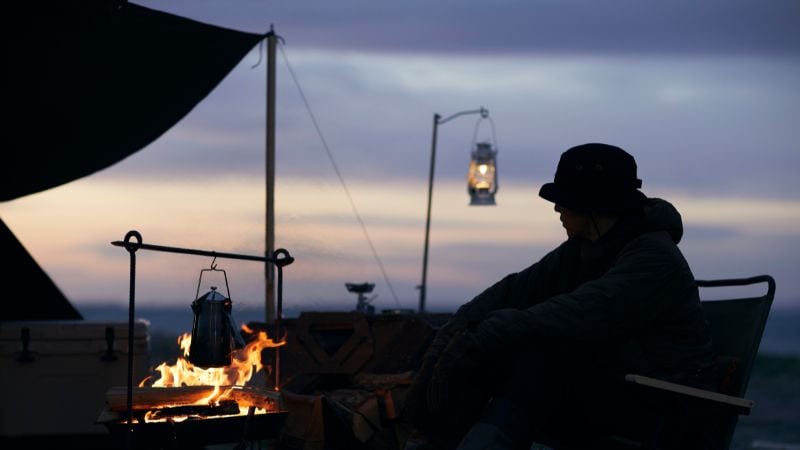
When selecting your camping lantern, take advantage of MF Opto’s 15+ years of lighting expertise. We offer free product consultations, custom logo printing options and bulk order capabilities.
Contact MF expert team for:
– Detailed product specifications
– Custom requirements discussion
– Sample requests
– Wholesale pricing information
[Request a Free Quote] or [Download Product Catalog] to explore the complete range of camping lantern solutions.




